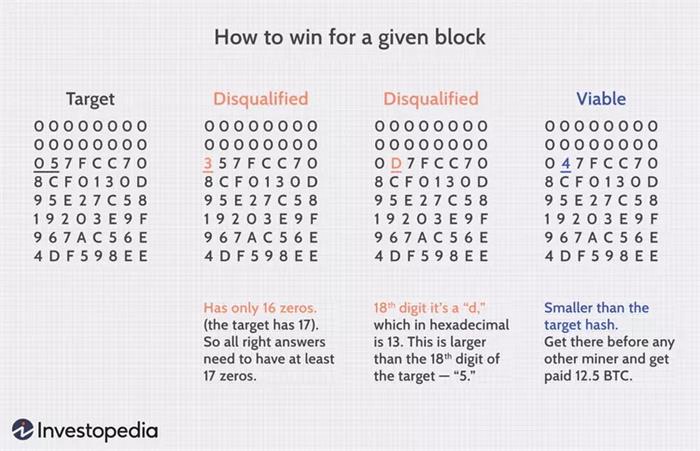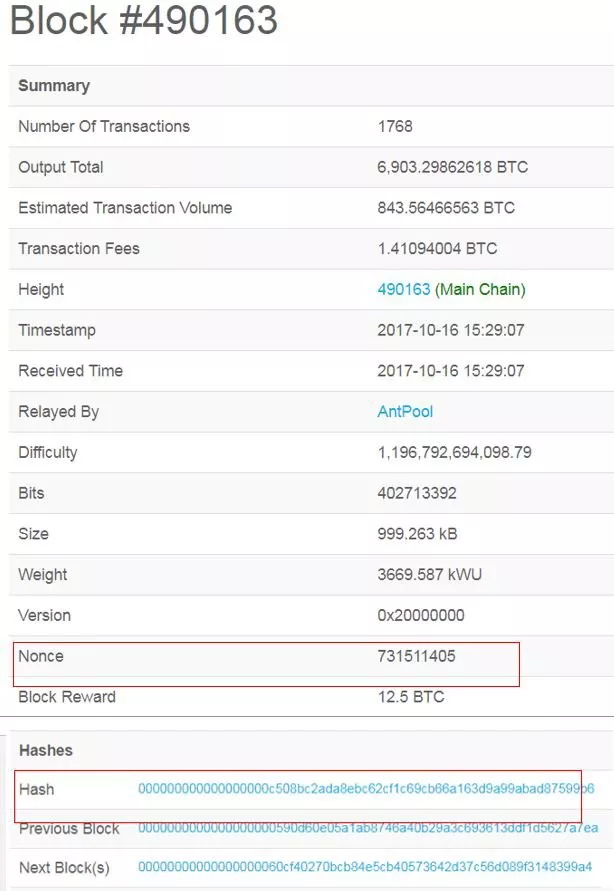What Is Bitcoin Mining?
Bitcoin mining is the process by which transactions are officially entered on the blockchain. It is also the way new bitcoins are launched into circulation.
Mining is conducted by miners using hardware and software to generate a cryptographic number that is equal to or less than a number set by the Bitcoin network's difficulty algorithm.
The first miner to find the solution to the problem receives bitcoins as a reward, and the process begins again. This reward is an incentive that motivates miners to assist in the primary purpose of mining: to earn the right to record transactions on the blockchain for the network to verify and confirm.
Before committing to investing your time and purchasing expensive equipment, read on to see whether mining is really for you.
Key Takeaways
Bitcoin miners receive bitcoin as a reward for creating new blocks which are added to the blockchain.
Mining rewards can be hard to come by due to the intense competition.
The probability that a participant will discover the solution is related to the network's total mining capacity.
Bitcoin mining requires substantial hardware and software.
Miners need a graphics processing unit (GPU) or an application-specific integrated circuit (ASIC).
How the Bitcoin Mining Process Works
Mining is a complex process, but in a nutshell, when a transaction is made between wallets, the addresses and amount are entered into a block on the blockchain. The block is assigned some information, and all of the data in the block is put through a cryptographic algorithm (called hashing). The result of hashing is a 64-digit hexadecimal number, or hash.
The Hash
Here is an example of a hash:
0000000000000000057fcc708cf0130d95e27c5819203e9f967ac56e4df598ee
The number above has 64 digits. As you probably noticed, that number consists not just of numbers but also letters. Why is that?
The decimal system uses factors of 100 as its base (e.g., 1% = 0.01). This, in turn, means that every digit of a multi-digit number has 100 possibilities, zero through 99. In computing, the decimal system is simplified to base 10, or the numbers zero through nine.
Hexadecimal, on the other hand, means base 16 because "hex" is derived from the Greek word for six, and "deca" is derived from the Greek word for 10. In a hexadecimal system, each digit has 16 possibilities. However, our numeric system only offers 10 ways of representing numbers (zero through nine). That's why you have to add letters—specifically, the letters A, B, C, D, E, and F.
Target Hash and Nonce
Miners are guessing a number that is lower than the target hash. The target hash is a hexadecimal number set to require an average number of attempts.
Miners make these guesses by adjusting the nonce, which is part of the information being hashed. Nonce is short for "number only used once," and it is the key to generating these 64-bit hexadecimal numbers. Due to size limitations, the block field the nonce is stored in only allows for a number of up to about 4.5 billion; it must be rolled over using another counter because generating 4.5 billion hashes takes less than one second. This counter comes from the coinbase transaction field, which is much larger—it is called the extra nonce. Using the nonce and the extra nonce as counters gives the blockchain the ability to generate an astronomical number of attempts.
When information is hashed, it always produces the same output unless something changes. So, the mining program sends block information with a zero as the first nonce through the hashing function. If that number is wrong, the nonce is increased by a value of one, and the hash is generated again. This continues until a hash that is less than the target hash is generated.
Here are some examples of hashes and the criteria for whether they would lead to success for the miner:

Hash Example
So, if you were to hash "Hello World!" using an online SHA256 generator, you might get:1
7f83b1657ff1fc53b92dc18148a1d65dfc2d4b1fa3d677284addd200126d9069
Add a digit to the end, like "Hello World!0" and rehash it. You might get:
e59f8bdf1305e382a4919ccefd613d3eebae612aa4c443f3af2d65663de3b075
Then, increase the number by one—"Hello World!1" and rehash it. You might get:
9e2be792bcd092bd5ab7bdac7bda1ae5d0db9f6d052a3c819615900c7c06e9be
This is mining, but it's done automatically by the mining program. It takes trillions of attempts for the network of miners to find the solution.
The Mining of Block 490163
The screenshot below, taken from the site Blockchain.info, might help you put all this information together at a glance. You are looking at a summary of everything that happened when block No. 490163 was mined.
The nonce that generated the winning hash was 731511405 (remember, the nonce starts at zero and increases by one every attempt). The target hash is shown on top. The entry of AntPool in the "Relayed by" field refers to the fact that this particular block was completed by AntPool, one of the more successful mining pools.
As you see here, the contribution to the Bitcoin community is that the pool confirmed 1,768 transactions for this block. If you would like to see all 1,768 transactions for this block, go to this page and look through the Transactions section.

You'll also notice the difficulty level for this block. The Bitcoin network aims to produce one block every 10 minutes or so. The system is designed to evaluate and adjust the mining difficulty every 2,016 blocks or roughly every two weeks (based on the number of participants). This doesn't always result in a blocktime of 10 minutes, but it's close.2
The mining difficulty number represents 2,016 divided by the average time it took to mine one block in the last period, multiplied by the old difficulty level, or:
= Old difficulty x ( 2,016 ÷ average time to mine in the last period )
The lowest difficulty level is 1.0. The higher the number, the more difficult the solution is to find. The difficulty level on March 9, 2024 (measured on March 7) was 79.35 trillion. You might see this published as 79.35T.3
Why Bitcoin Needs Miners
Blockchain mining is the computational work that network nodes undertake to validate the information contained in blocks. So, in reality, miners are essentially getting paid for their work as auditors. They are conducting the first verification of Bitcoin (BTC) transactions, opening a new block, and being rewarded for their work.
Why Mine Bitcoin?
One of the primary reasons people invest time and money in mining is for the reward of bitcoins, which, over time, have become very valuable. For example, on March 8, 2024, bitcoin's price topped $70,000 for the first time, closing at $68,285. The reward at the time was 6.25 bitcoin. Therefore, at the close of trading, that reward was worth $426,781.25.
The rewards for mining bitcoin are cut in half every four years.5 When first mined in 2009, one block would earn you 50 BTC. In 2012, this was halved to 25 BTC. By 2016, this was halved again to 12.5 BTC. On May 11, 2020, the reward was halved again to 6.25 BTC. The reward is predicted to halve again in April 2024 to 3.125 BTC.
Due to the halving process and increasing prices, miners want to receive as many bitcoins as possible because the supply of new coins is slowly dwindling. Sometime around 2140, there will be no more new bitcoins created.6
The competitive incentive to mine will disappear, with only the transaction fees remaining as a reason to participate in Bitcoin's network. Some miners might still participate as a way to take part in a decentralized currency, but it's likely that without the reward, most people will not want to mine. That is, unless the fees increase enough to make it worth their while.
What You Need To Mine Bitcoin
The majority of the Bitcoin network mining capacity is owned by large mining firms and pools. It is still possible to participate in Bitcoin mining with a regular at-home personal computer if you have one of the latest and fastest graphics processing units. However, the chances of receiving any reward by mining on your own with a single GPU in your computer are minuscule. You'll need to find a mining pool (discussed below) to increase your chances.
For instance, a processing card that you can purchase for a couple of thousand dollars would represent less than 0.001% of the network's mining power. It could be a long time—if ever—before you solve a hash because it's all about how many hashes per second your machine can generate. With such a slight chance of finding the next block, you may never recoup your investment.
Mining Hardware
To be able to mine with some chance for success, you'll need to invest in one of the top graphics processing units (GPUs, often called video cards) for your computer or an application-specific integrated circuit (ASIC). Capable GPUs can range in price from about $1,000 to $2,000; ASICs can cost much more, into the tens of thousands of dollars.
Today, most of the Bitcoin mining network's hashing power is almost entirely made up of ASIC machine mining farms and pooled individual miners. ASICs are many orders of magnitude more powerful than CPUs or GPUs. They gain more hashing power and energy efficiency every year as new chips are developed and deployed. For the right price (more than $11,000), you could mine at 335TH for 16.0 joules per tera hash (16 watts at one trillion hashes per second).8 There are much more affordable hardware versions, but the more you pay, the faster you can hash.9
Mining Pools
Mining pools are operated by third parties and coordinate groups of miners. By working together in a pool and sharing the payouts among all participants, miners have a better chance of being rewarded than they have working alone.
Most pools use a payout system based on how much work you contribute. For instance, if you have a GPU providing 121 mega (million) hashes per second and the pool has a total hash rate of 121 exa (quintillion) hashes per second, your reward, based on the shares of work you contributed, would be very small.
Contact: Amanda
Phone: 86-755-83240143
E-mail: thebestasicminers@gmail.com
Whatsapp:+8613424370509
Add: 1nd Floor,No.51 Building,Dongwu Industrial Park,Donghuan 1st Road,Pingshan New District, Shenzhen